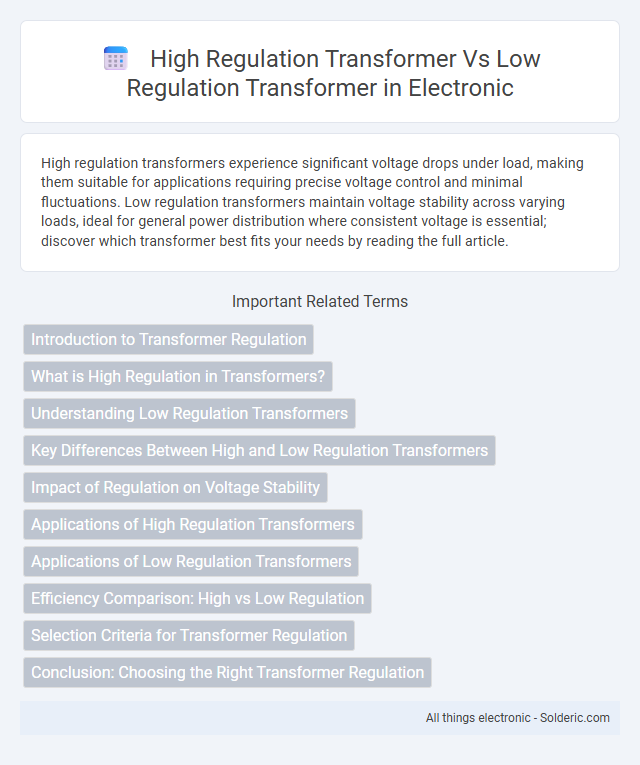High regulation transformers experience significant voltage drops under load, making them suitable for applications requiring precise voltage control and minimal fluctuations. Low regulation transformers maintain voltage stability across varying loads, ideal for general power distribution where consistent voltage is essential; discover which transformer best fits your needs by reading the full article.
Comparison Table
| Feature | High Regulation Transformer | Low Regulation Transformer |
|---|---|---|
| Voltage Regulation | High (typically >5%) | Low (typically <5%) |
| Voltage Stability | Poor under varying loads | Better under varying loads |
| Load Variation Handling | Less efficient | More efficient |
| Typical Applications | Laboratory or special purpose | Power distribution and general use |
| Efficiency | Usually lower | Higher efficiency due to stable voltage |
| Cost | Lower initial cost | Higher initial cost |
| Design Complexity | Simple design | More complex design with better regulation features |
Introduction to Transformer Regulation
Transformer regulation refers to the percentage change in secondary voltage from no-load to full-load conditions, indicating voltage stability under varying loads. High regulation transformers exhibit larger voltage drops under load, typically exceeding 5%, making them less suitable for sensitive equipment requiring steady voltage. Low regulation transformers maintain voltage variations within 1-3%, ensuring more consistent performance and better efficiency in power distribution systems.
What is High Regulation in Transformers?
High regulation in transformers refers to a significant change in secondary voltage as the load varies from no load to full load, often expressed as a percentage of the rated voltage. This characteristic indicates the transformer's inability to maintain a stable output voltage under varying load conditions, which can lead to inefficient power delivery and voltage drops. High regulation transformers are typically used where load sensitivity is low or voltage variation is acceptable.
Understanding Low Regulation Transformers
Low regulation transformers maintain voltage stability under varying load conditions by minimizing voltage drop, which is crucial for applications requiring consistent voltage supply. These transformers typically exhibit regulation values below 5%, ensuring efficient performance and reduced energy losses during operation. Understanding low regulation transformers helps you select the right equipment for sensitive electronics or critical power systems where voltage precision is essential.
Key Differences Between High and Low Regulation Transformers
High regulation transformers experience significant voltage drop under load, making them suitable for applications requiring stable voltage at varying loads but with higher losses and heating. Low regulation transformers maintain voltage close to the rated value with minimal drop, ideal for sensitive equipment demanding consistent voltage and greater efficiency. You should choose based on load stability needs, efficiency requirements, and operational environment.
Impact of Regulation on Voltage Stability
High regulation transformers exhibit significant voltage variation under load, causing fluctuating voltage stability that can disrupt sensitive equipment. Low regulation transformers maintain a more consistent voltage output despite load changes, ensuring improved system reliability and stable performance. Selecting transformers with low voltage regulation is critical in applications requiring precise voltage control and minimal power loss.
Applications of High Regulation Transformers
High regulation transformers are primarily used in applications where voltage variation under load is desirable, such as in voltage stabilization, testing equipment, and lighting transformers. They are ideal for scenarios requiring significant voltage adjustment or where the load varies substantially because their higher impedance limits fault currents and improves safety. If your system demands precise control of voltage changes with load fluctuations, high regulation transformers offer the necessary performance characteristics.
Applications of Low Regulation Transformers
Low regulation transformers are ideal for applications requiring stable voltage under varying load conditions, such as audio equipment, precision laboratory instruments, and sensitive communication devices. Their minimal voltage drop ensures consistent performance and prevents signal distortion in electronic circuits. These transformers are preferred in scenarios where equipment protection and voltage accuracy are critical for operational reliability.
Efficiency Comparison: High vs Low Regulation
High regulation transformers experience greater voltage drops under load, leading to reduced efficiency compared to low regulation transformers, which maintain more stable output voltages. Lower voltage variation in low regulation transformers minimizes energy losses and ensures better performance in sensitive applications. Choosing a low regulation transformer improves Your system's energy efficiency and reliability by maintaining voltage consistency under varying loads.
Selection Criteria for Transformer Regulation
Selection criteria for transformer regulation emphasize efficiency, voltage stability, and application-specific load requirements. High regulation transformers are chosen for applications demanding significant voltage adjustment under varying loads, ensuring precise voltage control. Low regulation transformers are preferred in systems requiring minimal voltage variation and higher efficiency under stable load conditions, reducing energy loss and improving performance.
Conclusion: Choosing the Right Transformer Regulation
High regulation transformers experience greater voltage variation under load, making them less suitable for sensitive electronic equipment that demands stable voltage. Low regulation transformers maintain consistent voltage levels, enhancing performance and longevity in critical applications like medical devices and precision instruments. Selecting the appropriate transformer regulation depends on balancing cost-efficiency with the specific load stability requirements of the application.
high regulation transformer vs low regulation transformer Infographic

 solderic.com
solderic.com